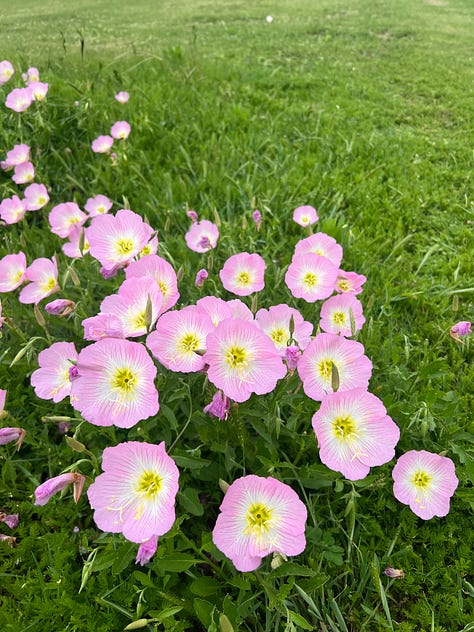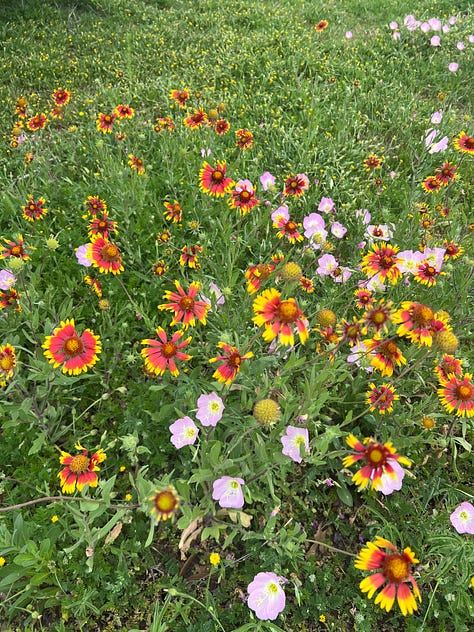In the last week it has rained 3 times. The ground is wet with dew in the mornings, the birds singing harmonies as they greet each other. The neglected rose bush in my yard has bloomed thirty-and-some-odd roses in bursts of fuchsia pink while crabgrass and a few sturdy dandelions have congregated the rest of the yard. Wishes stand at the ready to be made, while the yellow heads of those still waiting blow in the breeze. Spring is here.
We canceled our lawn service at the end of November due to price increases and the dead grass not in any need of mowing. But while we slept, the grass has grown so tall that my dog gets lost in our small back yard, and weeds have sprung up two feet high. Yet not half a mile down the road is a wide median on a four lane road that is bursting with wildflowers of all kinds. This is intentional on my city’s part, as they seek to foster habitats for local pollinators and fauna to thrive, ensuring future plant reproduction and reducing environmental impact.
I’m curious at this, how the one lot can be overgrown with nothing but weeds (dandelions notwithstanding) and the other can be alive with color. What makes the difference and how can we know at the beginning?
This is not an essay about pruning and gardening and cultivating. This is about the opposite, about letting things we didn’t plant grow and allowing them to be what they need to be.1
We did not plant the crabgrass or the chickweed. To my knowledge, the city didn’t plant those hundreds of coreopsis and evening primrose either. For the longest time, the landscapes were twins of one another, just swaths of grass too tall and unruly, looking like they could use a good ole’ chop. It wasn’t until the spring, when the buds arrived — or didn’t — that it was clear what each plot held.
As I walked by the wildflower field in the winter, I might have accused my city of neglect and indolence. I might have thought “What ugly weeds they’ve allowed to grow rampant here.” I may have started a campaign to have it mowed, and then we would all miss the dormant beauty waiting to spring up from the earth.
Growth is messy, and sometimes something is growing in us that we don’t remember planting. Something which we aren’t even sure what it is. I wonder if we’re too quick sometimes to cut out the wild things in us. The things that look a little haggard and contrary. The things that feel a little out of place. We’re uncomfortable with the upset to the status quo, so we sever it before it has a chance to bloom and show us what it is. But what if we let it grow? What if we let that dream, or habit, or relationship grow and see what fruit it bears. What if this shocking new desire in us is a wildflower waiting to bloom? What if we are so afraid of the weeds, we miss out on the rest of the meadow?



I would be remiss if I didn’t note that there is one primary difference between the wildflower field and my own front lawn: the location. More specifically, the soil. The wildflower-covered median in my city was apparently specially selected due to the quality and diversity of the soil there. It was uniquely suitable for fostering the growth of pollinating wildflowers. The soil in which we allow the wild things to grow matters, perhaps much more than the plant itself. But if we have tilled good soil, we can let the wild things grow in confidence.
We mustn’t be too afraid of the weeds. Once we see them for what they are, we can uproot them. Sure, it’s hard work, but it’s not the finality of a garden. The finality of a garden would be to pull all the local flora out before it has a chance to mature. The soil becomes barren, the pollinators die or migrate to another things. For fear of making any mistake, we don’t allow anything to grow at all.
Yes, I think it’s best if we occasionally let the wild things grow.
This is a poem I wrote in tandem for the above prose.
No-Mow Grow Zone
Dark has given way to warmth,
Cold has given way to growth,
Making way for the bald heads of flowers
pressing out from the earth.
One by one they unfurl their arms
Dancing on an unkempt stage,
Pirouetting in a grand ballet
As the folds of their skirts billow around them.
The Bluebonnets start the procession,
Marking the floor with
Their star-studded splendor
Announcing the parade of spring to come
The Pinkladies follow after,
Their heads bent together in great clusters
Their yellow tongues wagging,
As they gossip about the Echinacea and the Daisies
The bees carry the news to the Coreopsis
Whose scarlet eyes watch over the rest
Their fingers clasped in a wide trellis
Keeping safe their Woodsorrel children.
At last a lone and splendorous Goldenstar
Performs her grand jete.
The Verbena don their purple crowns
And the Bristly-Fruited Mallow chasse around her.
The ballet is coming to an end,
The finale performed with precision.
The curtained-curtsies are beginning:
The unbridled joy of the wildflowers.
I am no expert gardener. Allow me to take license to wax poetic on this topic and don’t get too lost in the weeds of the metaphor. (Get it?)



